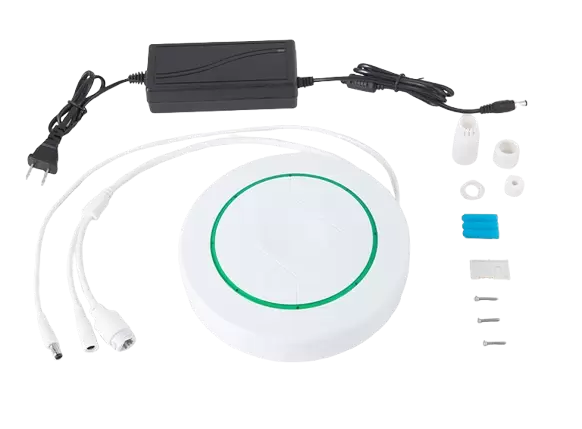With the widespread adoption of smart IoT technology in education, campus safety management is entering a new era of digitalization and intelligence. RFID school bus tracking systems, as a crucial component of student travel safety management, are increasingly being adopted by schools and educational institutions. They not only identify and track students, but also provide parents and school administrators with real-time visibility into the bus's operating status, effectively preventing safety hazards such as forgotten or misconnected buses. So, how exactly does an RFID school bus tracking system work? What are the technical principles behind it? This article will provide a detailed explanation.
1. Basic Concepts of RFID School Bus Tracking Systems
RFID (Radio Frequency Identification) is an automatic identification technology that uses radio signals to identify objects and obtain relevant data. In school bus management, the primary function of the RFID system is to identify students. Combined with the bus's GPS positioning system and data transmission module, it enables dual management of both students and vehicles. In short, the RFID school bus tracking system is a comprehensive information management platform based on RFID and IoT technologies. It operates through the collaborative operation of hardware devices (RFID cards, readers, and control terminals) and software platforms (data servers, parent apps, and school management terminals) to create an efficient, secure, and transparent student pick-up and drop-off management system.
2. How the RFID School Bus Tracking System Works
To understand the workings of the RFID school bus tracking system, we need to analyze the entire process from four stages: data collection → information transmission → real-time monitoring → abnormality alarms.
2.1 Data Collection: RFID Student Identification
In operation, each student is assigned a uniquely coded RFID card, which can be embedded in a student ID card, school badge, wristband, or badge. When a student boards or exits the bus, an RFID reader near the bus door automatically detects the card's signal and quickly identifies the student.
The system then automatically generates a data record containing the student's name, card number, boarding/disembarking time, and bus ID. The entire identification process requires no human intervention and is fast and highly accurate. RFID technology reads information without contact and is unaffected by light, weather, or direction, resulting in far higher recognition efficiency than traditional barcode scanning.
2.2 Information Transmission: Instant Data Upload to the Cloud
Once the RFID reader captures student information, the data is immediately uploaded to a cloud server via a 4G/5G communication module or Wi-Fi network. Simultaneously, the school bus's GPS positioning module transmits real-time information such as the vehicle's location, route, and speed.
This allows the backend system to automatically match student identity data with bus operation data, dynamically linking students to buses. For example:
A student boarded the bus at Station A at 07:30;
The bus is currently traveling along Route B;
It is expected to arrive at school at 08:10.
This real-time data is not only viewable by school administrators but can also be synced to the parent app, allowing parents to monitor their children's travel status in real time.

2.3 Real-Time Monitoring: Simultaneous Viewing by Parents and School Authorities
After the information is uploaded, the backend system monitors the bus's operating status and student boarding and alighting in real time. The system interface typically includes the following functional modules:
Real-time map display of school bus locations: This displays the bus's route using GPS tracking;
Student boarding and alighting records: This displays each student's boarding and alighting times and stops;
Driver and accompanying teacher information: This ensures accountability;
Parental notifications: This automatically sends notifications when students board the bus, arrive at school, or leave school.
For example, when a student boards the bus, the parent's phone will immediately receive a notification stating "Your child has boarded safely." When the bus approaches their home, the system can also provide a pre-announcement: "The bus is arriving soon, please prepare for pickup," significantly enhancing safety and convenience.
2.4 Abnormal Alarms: Intelligent Early Warning Mechanism
The RFID school bus tracking system not only identifies student information but also automatically generates alarms when an anomaly occurs. For example:
Students fail to board or alight on time: The system immediately notifies parents and administrators;
Students mistakenly board another bus: An alarm is automatically issued if the identification information does not match;
Vehicles deviate from the scheduled route: The GPS module detects an abnormal route and triggers an alarm;
Equipment failure or network disconnection: The backend system automatically records and alerts maintenance personnel. Through these intelligent early warning mechanisms, schools can promptly address potential safety risks and fundamentally prevent problems such as lost students and incorrect pick-up and drop-off.
3. Technical Advantages of the RFID School Bus Tracking System
3.1 Automated Identification, No Human Intervention Required
The RFID system automatically identifies students, eliminating errors such as manual check-ins and missed registrations, thereby improving work efficiency.
3.2 Real-Time Data Transmission and Information Transparency
Through wireless networks, student boarding and alighting information is instantly synchronized with parents and school administrators, ensuring real-time, accurate, and traceable information.
3.3 Strong Scalability and Compatibility with Multiple Systems
The RFID school bus system can share data with campus cards, access control systems, attendance systems, and other systems, forming a closed-loop smart campus management system.
3.4 High Security and Anti-Counterfeiting Capabilities
Each RFID tag has a unique ID and uses encrypted transmission to prevent copying and forgery, ensuring data security.
3.5 Data Statistics and Analysis


Average Rating